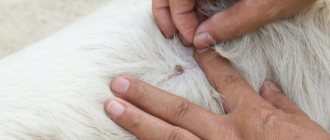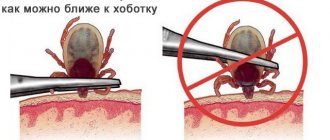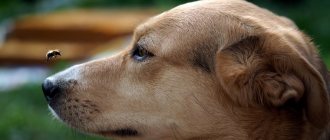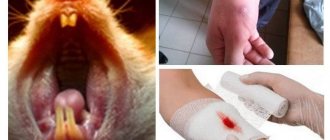4534Pavel
Due to hunting instincts, pets, when in the wild, often become victims of attacks by bees, hornets, wasps and some types of spiders. The reaction of a cat's body to the bite of stinging insects is unpredictable, since animals, like humans, are prone to allergies. If a cat was bitten by a wasp on the paw or back, then such bites may not be noticed by the owners of adult animals. These places are the least sensitive and the cat can cope with the problem on its own. In mild cases, inflammation and unpleasant itching go away within a few hours, and pain from touching the bite site lasts no more than two to three days.
If a wasp stings a kitten or an adult cat with increased susceptibility to insect venoms (Persian, British, Angora breeds), then in this case there is a possibility of death after the bite. Even if the bite fell on the least sensitive part of the body, it is worth considering that even a small portion of poison can provoke serious intoxication of the body.
© shutterstock
The symptoms of an allergic reaction are as follows::
- dyspnea
- vomit
- chills
- movement coordination disorders
- increased salivation
- hives
- convulsions
- in the most severe cases shock may occur
Every breeder or hobbyist should know a plan of action if the condition of an animal affected by a wasp sting worsens. If any of the above signs of an allergic reaction occur in your cat, you should immediately show it to a veterinarian. Experts in the field of veterinary medicine categorically do not recommend relying on your own experience or advice from numerous articles. Since each animal has an individual reaction to medications, the veterinarian monitors the cat for some time after their administration.
If a wasp bites you on the face, head or throat, there is a high probability of swelling spreading to the respiratory tract, which in turn provokes suffocation. A bite to the eye or nose is no less dangerous; such wounds are not without severe inflammation, which is fraught with suppuration of the mucous membrane and other complications.
If a wasp bites a cat on the stomach or groin, this can lead to swelling of the urinary tract. In this case, it is necessary to immediately get rid of the swelling by contacting a specialist, otherwise blockage of the urinary tract can lead to death.
For any animal, be it a cat or a dog, multiple stings from wasps or other stinging insects can have serious consequences. In this case, you should immediately contact a veterinary clinic.
Bitten by a wasp (bee): dangerous or not?
An insect bite is always very painful. Further developments depend directly on the dog’s immunity and tendency to express an allergic reaction. In 3-7% of cases, a wasp (bee) sting causes a severe reaction with complications, including death.
Bees rarely attack animals on their own initiative; bites are their natural defensive reaction to a dog’s “interest” in the nest or when a pet accidentally presses an insect. Bees, wasps, and bumblebees really do not like sudden movements, loud sounds, or unpleasant odors.
Preventing a Bite
Sometimes a bee or wasp may bite your cat despite your best efforts, so try to keep these insects out of your home. There are still steps you can take to reduce your pet's risk of being bitten.
If you find a nest or hive in your yard, call a professional to remove it safely. If an insect flies into the house, take the cat and all other pets into the room and lock the door. Do not open the door until you kill the insect or drive it outside. If your cat corners an insect, immediately check that it is safe. If the prey turns out to be a bee or wasp, remove the cat from the insect and lock it in another room until you deal with the raider. If you are using insect exterminator to get rid of wasps or hives, be sure not to get it on your cat, as it could make her sick or die.
A bee sting is not always a reason to panic, but it is always something to take seriously. A quick reaction and careful observation of your cat will help you save its life.
Why is poison dangerous?
Insect venom is a biological fraction to which there can be an allergic reaction of varying intensity. Bee venom contains:
- magnesium;
- calcium;
- phosphorus;
- proteins, fats and carbohydrates;
- hydrochloric and phosphoric acids.
The most dangerous toxin is melitin; when it enters the victim’s blood, it provokes the destruction of red blood cells, thereby changing the natural metabolic processes and lack of oxygen in the tissues. Its action increases the permeability of blood vessels and anemia develops.
Histamine - enhances the allergic reaction, it is against this background that visible swelling develops at the site of the bite, blood pressure drops, blood vessels dilate and the permeability of capillary walls increases. The most dangerous consequence of a bite is bronchospasm, in which the animal stops breathing normally, hypoxia and suffocation occur. If a severe allergic reaction to insect venom occurs, death can occur.
Hyaluronidase is a component of wasp (bee) venom that destroys mucopolysaccharides, hyaluronic acid, which is part of connective tissue. As a result, swelling from the bite spreads quickly.
How to help using traditional methods?
What to do if a cat is bitten by a wasp? Some owners of four-legged pets, when bitten by a stinging insect, prefer to use traditional methods that do not cause harm to health and are used without restrictions. Of course, in terms of effectiveness they cannot be compared with medications, but they can still alleviate the cat’s condition. The main thing is to apply them, as they say, “without delay.”
So, to relieve swelling the following are often used:
- apple, lemon, orange (apply a piece to the sore spot, they partially neutralize the poison after the bite);
- infusion of chamomile, calendula (process in the same way as with soap solution);
- turmeric powder diluted with water (it relieves inflammation and itching).
However, if the cat's condition rapidly deteriorates, and none of the measures helps, you should immediately take the animal to the veterinarian, otherwise the consequences could be fatal.
Clinical signs of insect bites
The first thing the breeder will notice is the squeal of the dog (meowing of the cat) - at the moment when the bee sticks the sting, severe pain occurs. The pet can spin around in place, rub its nose and other part of the body where the bite occurred with its paw.
Further swelling develops, the bite site rises above the healthy skin and becomes red. The configuration of the muzzle changes, there may be asymmetry, the eyes may become swollen - if the bite occurred on these parts of the body.
The animal’s body is individual, so the severity of the allergic reaction is unpredictable - from minor swelling to extensive damage to the skin coupled with a deterioration in the general condition. A dog (cat) may vomit, hives appear on the skin, apathy, anorexia, trembling, signs of suffocation, Quincke's edema appear.
It is important to know! If the breeder notices that after a bee sting the animal suddenly becomes ill, the swelling is spreading at high speed, and the pet begins to choke, help is urgently needed. It can be provided only by relieving the allergic reaction, stopping the breakdown of red blood cells, etc. Therefore, assistance is provided only in a veterinary clinic.
Symptoms of a wasp sting in a cat
In some long-haired breeds (Persian, Angora, etc.), swelling may not be visible due to long hair. Trouble can be suspected by a change in the pet's behavior - it becomes angry, aggressive, does not allow the person who wants to examine it to approach it, and meows pitifully.
INTERESTING TO KNOW: How to stop cats from shitting in the entrance
In addition to the pain and itching that are characteristic of a stinging insect bite, the owner should be alert to the following symptoms indicating an allergic reaction:
- swelling in a certain place, edema;
- shortness of breath, difficulty breathing;
- vomiting (in some cases);
- increased salivation;
- hyperthermia;
- cardiopalmus;
- chills;
- movement coordination disorder;
- shock;
- loss of consciousness;
- convulsions.
If a wasp sting is suspected and the condition of a cat or dog worsens, the owner should take immediate action.
First aid for a bee sting
Ideally, after a bite, the breeder should deliver the animal to the RosVet EC; the clinic is open 24 hours a day. But if force majeure occurs and it is impossible to deliver the dog (cat) in the near future, you should:
- use tweezers to remove the sting from the wound;
- treat the bite site with an antiseptic;
- apply cold to the site of swelling;
- Fenistil, Advantan, and hydrocortisone ointments are applied topically.
To prevent the pet from scratching the bite site, a protective collar is put on it. You should not give antiallergic (antihistamine) drugs from a human first aid kit without a veterinarian's prescription. It is necessary to correctly calculate the dosage, otherwise poisoning will join the allergy.
If your dog or cat was bitten by a bee (wasp, bumblebee) - do not hesitate! Insect venom is a huge allergen and has an unpredictable effect on the animal. Call the RosVet VC, calls are accepted 24 hours a day. Specialists are available 24 hours a day, including calling a team to your home.
First aid for a pet attacked by stinging insects
You can tell that a cat has been bitten by a wasp by the swelling of the wound and the animal’s general malaise. If a cat is bitten, you should help immediately, because the dose of poison per kilogram of the pet’s weight can be very large. In addition, the pet experiences pain and discomfort no less than a person in a similar situation.
If a wasp stings on the paw or back, then it is enough to provide the animal with peace in a cool room. Next, you should inspect the wound for the presence of a sting. In rare cases, wasps leave a sting in the wound after a bite, but if this happens, it must be carefully removed with tweezers. It is very important not to crush the sting, otherwise even more poison will get into the wound.
You can relieve inflammation from a bite in the following ways::
- treat the wound with soapy water
- A solution of 9% vinegar and water in a 1:1 ratio will also help relieve inflammation.
- treat the bite with a small piece of apple, a slice of orange or a cotton swab moistened with the juice of any fruit containing natural acids
- sprinkle the bite area with turmeric
- Essential oils of lavender or thyme will help remove swelling
- A cotton swab soaked in chamomile infusion will help relieve inflammation.
If necessary, apply a cool compress to the inflamed area if the cat allows it. A wasp sting in a safe place will not entail any consequences for an adult and healthy cat other than inflammation and unpleasant sensations. The best help for an injured animal is to treat the wound and leave it alone.
If a cat has been bitten by a wasp in the eye, nose or lip, then you should know that swelling near the mucous membrane can only be removed with medications that will not cause a burning sensation and will not damage the animal’s sense of smell. Therefore, immediately after discovering a bite, you should contact a veterinarian.
In most cases, the body of an adult cat copes with wasp stings without any consequences. Even with a bite to the head, throat or groin, the immune system of a healthy adult animal is able to fight intoxication on its own. In some cases, a wasp sting is not even accompanied by swelling, but only redness, which is practically invisible under the fur. But no matter how strong the animal’s immunity, any cat owner should know what needs to be done when stinging insect bites are detected.
© shutterstock
Prevention
It is almost impossible to completely protect your cat from being bitten, but when he spends the summer season outdoors, the possibility of insect damage should be minimized. For this:
- The windows are covered with mosquito nets, the doors are hung with curtains;
- Periodically inspect the territory, destroy existing bee nests;
- Treat pets with repellents.
It is not recommended to feed cats outside; here it is much easier for insects to get into the food, and accordingly the risk of being struck by a wasp is much greater.
— How to recognize the symptoms of rabies?
— Often the disease begins with a picture of a common viral infection, namely:
- General weakness;
- Headache;
- Heat.
The patient may notice redness in the bite area and complain of burning and pain.
These symptoms are gradually accompanied by insomnia, irritability, and fear of air and water. When a person with rabies sees water, the esophagus and respiratory muscles begin to spasm, and a large amount of saliva is released.
In the end, delusions, hallucinations, and paralysis develop. The patient dies within 7-8 days from the onset of the first signs of the disease.
Where do they bite most often?
If there is a suspicion that the cat was stung by wasps, then the entire body should be completely examined. In long-haired pets you may not see swelling.
However, most often arthropods injure the pads of the front paws and the area of the nasolabial triangle, since it is with these parts of the body that the cat tries to catch the insect. A little less often they bite just above the pads and in the muzzle.
Hymenoptera bite in other places much less frequently, since indiscriminate biting is only done by an angry individual, and the injured animal immediately runs away after the first bite. The remaining areas of the body are protected by a thicker coat. The exception is hairless breeds.
How to give a cat an injection yourself
As described above, in many cases the owner will have to give the cat an intramuscular injection himself. For many, it is a big problem to give an injection to a person, not to mention an unconscious animal. However, this must be done, and how to do this will be described below.
It all starts with choosing a syringe. For injections, you can use regular syringes, which are sold at the pharmacy. Since the dosage of drugs is usually limited to one standard ampoule, there is no point in taking a 10 cc syringe. A standard 2cc is best. If the injection is to be given to a kitten, then you can limit yourself to insulin. These syringes have the thinnest needles and the injection will be less painful.
Anyone can handle putting medicine into a syringe. It is important that there is no air in the syringe. After dialing, you can lightly press the plunger so that the medicine enters the needle and all the air comes out.
Next, you need to involve all your household or neighbors. It is advisable to wear thick clothing, as the animal is irritated and will protect its integrity.
The pet must be secured so that the middle of the thigh is open for the injection. You can pour alcohol over the injection site. Next, insert the needle. You don’t have to worry too much about the depth - 5-10 mm is the most optimal penetration depth.
Proper restraint of the animal
Important! First you need to insert the needle to the required depth, quickly make sure that the injection is placed correctly and only then press the piston.
After fixing the position, slowly press down on the piston. There is no need to do this abruptly. Then carefully remove the needle from the animal’s body and treat it with alcohol again. If the animal lies obediently, you can apply cotton wool for a while.
A wasp or bee sting is quite dangerous for cats, especially very small ones. The danger is not so much the bite itself, but the allergic reaction that may follow it. Just like in humans, in cats it can be expressed by spasm and swelling of the airways. As a result, the animal may simply suffocate. To prevent this from happening, you must always keep it at home, and if this is an outing, take with you anti-allergenic and anti-inflammatory drugs. If your own skills to help a stung cat are not enough, you need to urgently take the animal to a veterinary clinic.
What could be the consequences?
Has your pet been bitten by wasps or bees?
Not really
In young healthy cats, the bite will most often pass without consequences. But in some cases, consequences are possible: if the kitten is still small, when there is an allergy or the bite site is life-threatening: the eye, tongue, genitals.
In serious cases, the animal experiences anaphylactic shock, which can be fraught with serious consequences.
With allergies, signs of anaphylactic shock appear:
- rash;
- increased heart rate;
- decreased body temperature;
- disorientation in space;
- vomit;
- diarrhea.
Why do cats bite?
Cats can, of course, become aggressive when they are scared or feel threatened. But many also tend to bite and scratch when petted by their owner. This is called petting-induced aggression, and it has been a topic of discussion among behaviorists for decades. There are three theories why cats do this. First, they are simply letting their owner know that they are no longer happy to be petted. Secondly, they are trying to establish their status. Thirdly, a person who pets them for a while causes negative emotions in cats. It is important for owners to learn more about their cats in order to recognize the telltale signs of aggression caused by petting.
Allergy medications
Veterinarians recommend the following medications as emergency treatment:
- prednisolone 0.5 ml IM or tablets;
- dexamethasone 0.2 ml IM;
- Benadryl.
Bite on the paw
However, the list of medications should be used only if absolutely necessary. It is advisable to go to a clinic for qualified treatment, since drugs can suppress protective functions and lead to secondary infection.
Adrenaline is administered in clinical settings, but it is prohibited to use it at home, since an incorrectly calculated dosage leads to death.
Pharmacy products
There are no special medications for cats.
- To eliminate minor allergies, creams based on medicinal herbs, tinctures, Zvezdochka balm, Bepanten, Menovazin are used.
- To eliminate moderate allergies, Fenistil gel is used.
- With a pronounced clinical picture, antiallergic hormonal ointments are required - Advantan, Elokom, Betamethasone, Triaccutane.
- If an infection gets into the wound, the sore spots are treated with a local antibiotic - Levomekol, Tetracycline, Erythromycin, Gentamicin.
The cat's skin should be treated 1-4 times a day; as the symptoms disappear, the dosage is reduced. Therapy lasts no more than 5 days. If the situation does not improve within 2 days, you need to show the cat to a veterinarian.
Tags
the cat was bitten by a wasp Consequences of a wasp sting When a wasp stung A bee sting A hymenoptera sting Urine. A bite in a cat was bitten by a wasp wasp bite wasp bite place of a wasp sting Cats Cats Cats Cats' bodies can be detected by a cat's body bitten cats lead angora cats have if a cat was bitten when a cat was bitten by a wasp bite by a wasp kitten the bite of a wasp stings or wasps can Particularly dangerous wasp bitten by a wasp sting for cats Grooming cats Feeding cats Neutering cats for cats lives of cats for cats Grooming cats A bee sting or than a bee. or a bee appears or a bee. bitten by a bee. A bee tries to bite a bee
pawallergiesbreathingcauseanimaldiseasesstungdoctoreyesrodentsorganismyoursuchcommentillnessothersimmediatelyanyveterinarian
What to do if bitten by a hornet
Hornet stings are especially painful. If an animal is attacked by several individuals, you need to contact a specialist; due to the high toxicity of numerous bites, there is a high probability of the animal’s death. The greatest danger is posed by hornet bites if an animal of a small breed is attacked.
If the animal does not show particular concern after being bitten by a hornet, there are no signs of allergies or anaphylactic shock, it is sufficient to use methods classified as alternative medicine.
If there are no negative consequences of a hornet sting, you need to treat the wound with agents that will help prevent swelling, infection, and neutralize pain and discomfort.
— Does the animal with rabies show any symptoms?
— Yes, a dog with rabies has certain signs that appear 12-20 days after the bite. The animal's behavior changes: it avoids people, howls, is in no mood, often angry, does not eat, does not drink water, can swallow unusual objects (a piece of wood, rags, nails). After 1-2 days he becomes aggressive, a large amount of saliva comes from his mouth, has an unsteady gait, runs away from home and often gets lost, after 2-3 days paralysis begins, and dies on the 7th or 8th day.
10 days before symptoms of the disease appear, saliva is dangerous because it already contains the rabies virus!











